1. Korean Society Hypertension (KSH). Hypertension Epidemiology Research Working Group. Kim HC, Cho MC. Korea hypertension fact sheet 2018. Clin Hypertens. 2018; 24(1):13. PMID:
30288297.

4. Bell CS, Samuel JP, Samuels JA. Prevalence of hypertension in children. Hypertension. 2019; 73(1):148–152. PMID:
30571555.

5. Du T, Fernandez C, Barshop R, Chen W, Urbina EM, Bazzano LA. 2017 pediatric hypertension guidelines improve prediction of adult cardiovascular outcomes. Hypertension. 2019; 73(6):1217–1223. PMID:
31006329.

6. Chen X, Wang Y. Tracking of blood pressure from childhood to adulthood: a systematic review and meta-regression analysis. Circulation. 2008; 117(25):3171–3180. PMID:
18559702.
7. Chiolero A, Bovet P, Paradis G. Screening for elevated blood pressure in children and adolescents: a critical appraisal. JAMA Pediatr. 2013; 167(3):266–273. PMID:
23303490.
8. Pickering TG, Hall JE, Appel LJ, Falkner BE, Graves JW, Hill MN, et al. Recommendations for blood pressure measurement in humans: an AHA scientific statement from the Council on High Blood Pressure Research Professional and Public Education Subcommittee. J Clin Hypertens (Greenwich). 2005; 7(2):102–109. PMID:
15722655.

9. Flynn JT, Kaelber DC, Baker-Smith CM, Blowey D, Carroll AE, Daniels SR, et al. Clinical practice guideline for screening and management of high blood pressure in children and adolescents. Pediatrics. 2017; 140(3):e20171904. PMID:
28827377.
11. Barba G, Buck C, Bammann K, Hadjigeorgiou C, Hebestreit A, Mårild S, et al. Blood pressure reference values for European non-overweight school children: the IDEFICS study. Int J Obes. 2014; 38(Suppl 2):S48–56.

12. Ke L, Brock KE, Cant RV, Li Y, Morrell SL. The relationship between obesity and blood pressure differs by ethnicity in Sydney school children. Am J Hypertens. 2009; 22(1):52–58. PMID:
18989256.

13. Harding S, Whitrow M, Lenguerrand E, Maynard M, Teyhan A, Cruickshank JK, et al. Emergence of ethnic differences in blood pressure in adolescence: the determinants of adolescent social well-being and health study. Hypertension. 2010; 55(4):1063–1069. PMID:
20194305.
14. Lee HA, Park EA, Cho SJ, Kim HS, Kim YJ, Lee H, et al. Mendelian randomization analysis of the effect of maternal homocysteine during pregnancy, as represented by maternal MTHFR C677T genotype, on birth weight. J Epidemiol. 2013; 23(5):371–375. PMID:
23856949.

15. Lee HA, Kim YJ, Lee H, Gwak HS, Hong YS, Kim HS, et al. The preventive effect of breast-feeding for longer than 6 months on early pubertal development among children aged 7–9 years in Korea. Public Health Nutr. 2015; 18(18):3300–3307. PMID:
25743129.

16. National High Blood Pressure Education Program Working Group on High Blood Pressure in Children and Adolescents. The fourth report on the diagnosis, evaluation, and treatment of high blood pressure in children and adolescents. Pediatrics. 2004; 114(2 Suppl 4th Report):555–576. PMID:
15286277.
17. R Core Team. R: a language and environment for statistical computing. Updated 2018. Accessed August 29, 2019.
https://www.R-project.org.
18. Rigby RA, Stasinopoulos DM. Generalized additive models for location, scale and shape. Appl Stat. 2005; 54(3):507–554.
19. Xi B, Zong X, Kelishadi R, Hong YM, Khadilkar A, Steffen LM, et al. Establishing international blood pressure references among nonoverweight children and adolescents aged 6 to 17 years. Circulation. 2016; 133(4):398–408. PMID:
26671979.

20. Lurbe E, Cifkova R, Cruickshank JK, Dillon MJ, Ferreira I, Invitti C, et al. Management of high blood pressure in children and adolescents: recommendations of the European Society of Hypertension. J Hypertens. 2009; 27(9):1719–1742. PMID:
19625970.

21. Yan W, Liu F, Li X, Wu L, Zhang Y, Cheng Y, et al. Blood pressure percentiles by age and height for non-overweight Chinese children and adolescents: analysis of the China Health and Nutrition Surveys 1991–2009. BMC Pediatr. 2013; 13(1):195. PMID:
24274040.

22. Rosner B, Cook N, Portman R, Daniels S, Falkner B. Determination of blood pressure percentiles in normal-weight children: some methodological issues. Am J Epidemiol. 2008; 167(6):653–666. PMID:
18230679.

23. Juonala M, Magnussen CG, Berenson GS, Venn A, Burns TL, Sabin MA, et al. Childhood adiposity, adult adiposity, and cardiovascular risk factors. N Engl J Med. 2011; 365(20):1876–1885. PMID:
22087679.

24. Sohn JA, Lee HS, Lim KA, Yoon SY, Jung JW, Kim NS, et al. Normal blood pressure values and percentile curves measured by oscillometric method in children under 6 years of age. Korean J Pediatr. 2008; 51(9):998–1006.

25. Lee CG, Moon JS, Choi JM, Nam CM, Lee SY, Oh K, et al. Normative blood pressure references for Korean children and adolescents. Korean J Pediatr. 2008; 51(1):33–41.

26. Flynn JT, Pierce CB, Miller ER 3rd, Charleston J, Samuels JA, Kupferman J, et al. Reliability of resting blood pressure measurement and classification using an oscillometric device in children with chronic kidney disease. J Pediatr. 2012; 160(3):434–440.e1. PMID:
22048052.

27. Johansson S, Iliadou A, Bergvall N, Tuvemo T, Norman M, Cnattingius S. Risk of high blood pressure among young men increases with the degree of immaturity at birth. Circulation. 2005; 112(22):3430–3436. PMID:
16301344.

28. Moon JS. Secular trends of body sizes in Korean children and adolescents: from 1965 to 2010. Korean J Pediatr. 2011; 54(11):436–442. PMID:
22253640.

29. Lee CG, Park HM, Shin HJ, Moon JS, Hong YM, Kim NS, et al. Validation study of the Dinamap ProCare 200 upper arm blood pressure monitor in children and adolescents. Korean J Pediatr. 2011; 54(11):463–469. PMID:
22253643.

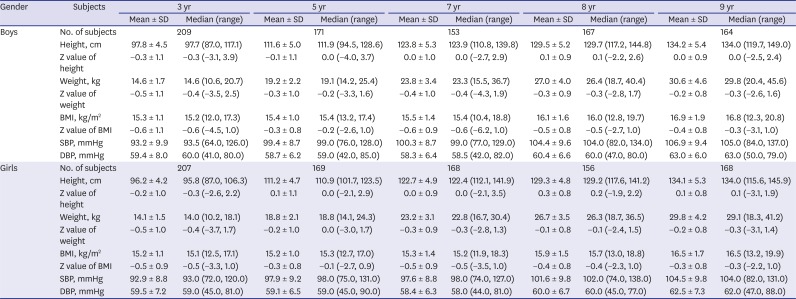
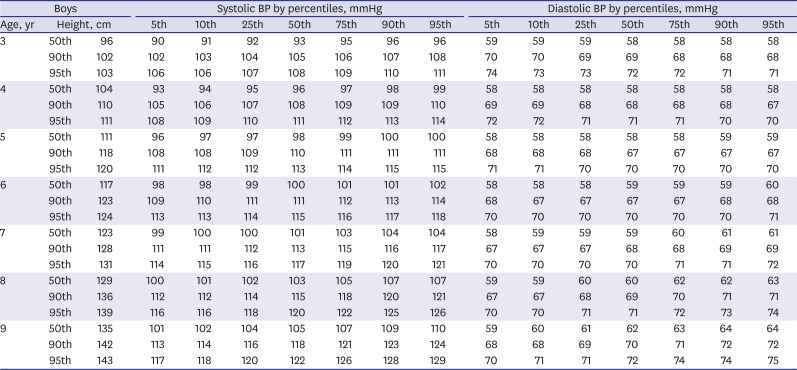
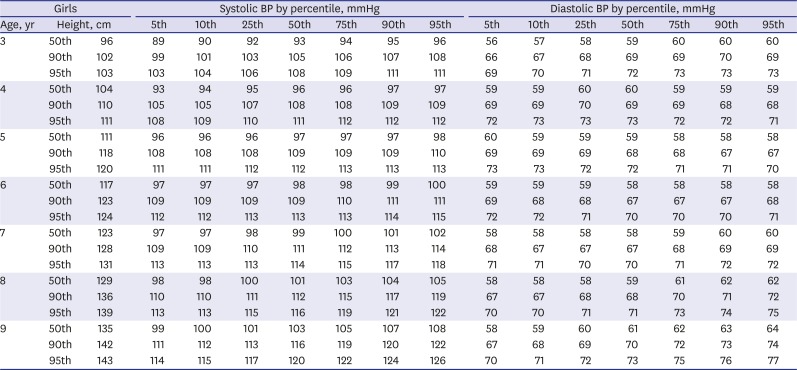
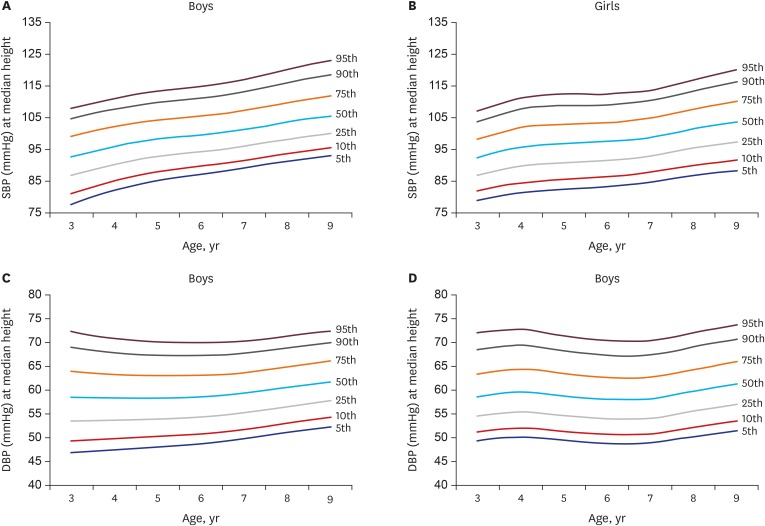





 PDF
PDF Citation
Citation Print
Print



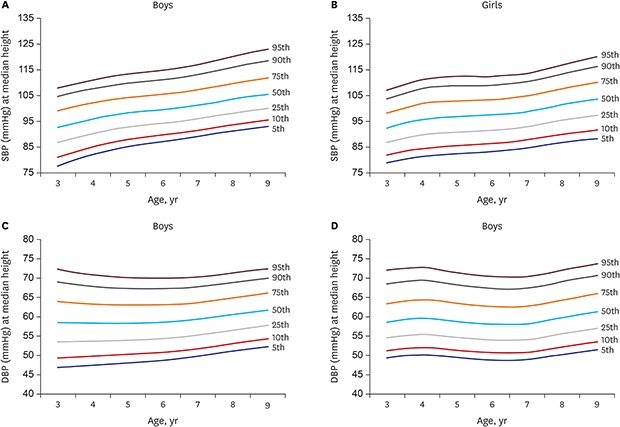
 XML Download
XML Download